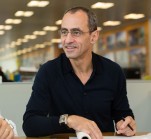Interview with Keith Griffiths

Below we represent the TB magazine interview with our first guest - Keith Griffiths, the founder of AEDAS, one of the largest architectural firms in the world, who has kindly agreed to answer the questions of our edition.
What are the most important trends in modern architecture from your point of view? How much the concept of a new building should depend on the specifics of national architecture and location characteristics in terms of architecture?
With rapidly urbanising economies and densifying cities, large mixed-use schemes will become significant not just in Asia, but also in Europe, Americas and the Middle East. The world is looking for more efficient, sustainable and vibrant cities. Mixed-use developments along existing roads and railways will become urban hubs that house office, retail, residential or hotel spaces all in one complex, significantly shorten journey time between work, live and play areas. We believe that the public realm will be extended to basement and upper levels of buildings and will connect across and between buildings in a connective tissue of retail, dining and entertainment facilities which will become the community hub of high-density developments.
At Aedas, we believe that great design can only be delivered by people with a deep social and cultural understanding of the communities they are designing for. We have a fascination for and high regard for the social and environmental differences of different cultures and communities. These differences have been cultivated over many years. They are the reason that the world is unique and exciting to experience. This is why we have set up 14 global offices across the world and created a global platform for creative excellence in design to enable some of the world's most talented designers to plug into the latest information and delivery systems they need to produce truly world-class design solutions all over the world. All our clients, no matter they are in Russia, London, Dubai or Beijing, can benefit from our collective expertise.
In which country would you like to build your new building? Which of your conceptual projects would you like to implement?
I am happy to design a new building anywhere. I am just passionate to create unique and timeless architecture which appropriately responds to its location and culture and meets the requirements of change and growth. Like any other architects, I would like to implement all my conceptual projects.
In which country have you managed to implement your idea of the project most accurately?
No matter where we work we have the delivery systems to make great design a reality. Delivery is one of our core values. Great thinking is meaningless if it does not become reality. We have invested heavily in system and processes to ensure that our ideas are executed to the highest standard and that our designers can draw on the latest technical expertise.
What do you think about architecture of Russian skyscrapers, particularly about International Trade Center Moscow City? Which of them do you like best?
Aedas is not currently working in Moscow so we have no detail comment upon International Trade Centre Moscow City.
Is it possible to switch to design of the shape of a building by just mathematical methods? Or computer modeling is just a supporting tool in an architect’s creative process?
Building design is a highly complex process involving the interaction of many consultants and decisions. It is not possible to switch design using computer models. Computer models are only a design tool.
Do you use BIM standards in your company? Could you tell about them more. How did you implement them?
Yes, we use BIM at Aedas. BIM can improve productivity and reduce errors during the design stage. It also reduces conflicts and changes during construction to avoid rework and minimise construction waste generation. As a result, it speeds up the delivery of building and reduces cost. These benefits are already well-known in the building industry.
We usually deploy BIM since the early design stage of a project, as we share the same philosophy of Pareto's Principle – the 80-20 rule. We believe that 80% of the major design decisions are determined in the first 20% of the design process. The impact and opportunity on environmental or sustainable design will be efficient and cost effective during the early design stage.
You give a lot of lectures about architecture and design in many countries. What advice do you usually give young architectures who want to replicate your success?
I would say it is important for young architects to expose themselves to different cultures and building types, be open minded, and always look to innovate and push the boundaries of what’s possible.


